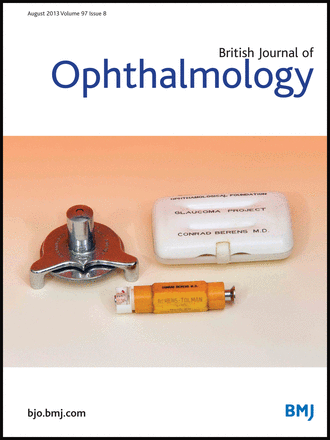In questo studio occhi affetti da maculopatia essudativa, già trattati con iniezioni intratìvitreali di Lucentis o Avastin, che mostravano una persistenza del quadro essudativo, sono stati trattati con il nuovo farmaco Eylea.
I risultati mostrano una significativa risposta con il nuovo trattamento, che riguarda soprattutto l’aspetto anatomico e la scomparsa di fluido all’esame OCT, mentre vantaggi meno netti si sono avuti sotto il profilo del miglioramento visivo.
L’Eylea si conferma un prezioso strumento terapeutico nel trattamento della maculopatia senile essudativa, in particolar modo nei casi aggressivi e resistenti alle altre terapie oggi disponibili.

Aflibercept for exudative AMD with persistent fluid on ranibizumab and/or bevacizumab
Hyung Cho, Chirag P Shah, Marissa Weber, Jeffrey S Heier
British Journal of Ophthalmology
2013 Aug;97(8):1032-5.
Objective To investigate the effect of aflibercept 2.0 mg in cases resistant to ranibizumab 0.5 mg and/or bevacizumab 1.25 mg treatment.
Purpose To evaluate the anatomic and visual effect of intravitreal aflibercept 2.0 mg in cases of exudative age-related macular degeneration (AMD) with persistent fluid on optical coherence tomography (OCT) despite regular ranibizumab 0.5 mg and/or bevacizumab 1.25 mg treatment at 1 and 6 months.
Methods Retrospective review at Ophthalmic Consultants of Boston, Boston, Massachusetts, USA of exudative AMD cases with persistent fluid on regular ranibizumab 0.5 mg and/or bevacizumab 1.25 mg treatment switched to intravitreal aflibercept 2.0 mg treatment and followed for 6 months. Tabulated data included details of prior treatments, best available visual acuity, central subfoveal thickness on registered spectral domain OCT before and after aflibercept injection centred on the anatomic fovea and macular description before and after aflibercept injection.
Results A total of 353 eyes with exudative AMD were switched to aflibercept during the study period. Of these, 28 eyes in 28 patients had persistent fluid after an average of 20 regular ranibizumab/bevacizumab injections (range 7–37). At 1 month, 89% (25 eyes) showed anatomic improvement and 18% (five eyes) were dry after a single aflibercept injection. Central subfoveal thickness improved from 295 to 272 microns (p<0.001) after one aflibercept injection. After an average of 4.4 aflibercept injections (range 3–6) over 6 months, the central subfoveal thickness remained improved (274 microns, p=0.008); 64% (18 eyes) showed anatomic improvement and a quarter of eyes (25%, seven eyes) were dry. Visual acuity did not improve at 1 month (logarithm of minimum angle of resolution (logMAR) 0.54, Snellen 20/69, p=0.64) or 6 months (logMAR 0.57, Snellen 20/76, p=0.49). Treatment was well tolerated with no adverse events reported.
Conclusions A significant proportion of exudative AMD cases with persistent fluid on OCT despite regular ranibizumab 0.5 mg and/or bevacizumab 1.25 mg treatment respond anatomically to aflibercept 2.0 mg. Visual acuity did not improve. Aflibercept may be beneficial anatomically in cases of exudative AMD treated with persistent fluid on ranibizumab and/or bevacizumab.
